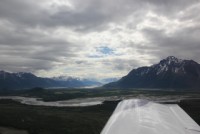
|
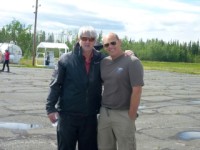
|
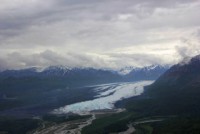
|
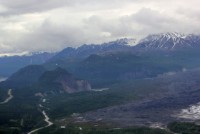
|
Once again we hit a flying day, and the weather didn't
quite cooperate. The night before, we had a pre-briefing
and were told that everyone should probably go IFR if you
can go IFR, because the ceilings were going to be tough,
and it wasn't sure that we would make it to
Ketchikan. The weather near Whittier and South along
the coast wasn't looking good. The problem I saw
with it was that IFR meant ice. The standard lapse
rate told me. I just knew that wasn't going to work.
So, I stayed up late at night mulling it over and
basically had resigned myself to giving up the last stop
(Ketchikan) of the trip if it meant IFR, and just head
back inland and back home via the inland route. The
weather more inland was looking better, and I knew I
couldn't delay too long my trip home, so that was the
compromise plan I came up with.
In a discussion with another pilot, we talked about going
IFR. I write this because it's good thinking for
anyone who thinks they want to get and use an instrument
rating... They felt that IFR would be a good option,
even with terrain and unfamiliar airports, if it could be
done without ice. However, they felt they would only
go IFR if they could get a 1500' ceiling at the
destination. That led me right into a good
discussion. The weather changes pretty darn fast in
Alaska, and especially in the areas along the coast.
Along with that, the Southern coasts get some of the
highest amounts of IFR days of anywhere in the
place. So I said, "what if the ceiling is going to
be 1200' overcast?" They said, "Well, I guess I'd
go." I said, "What if the ceiling ends up going down
to 800'?" Again, "Well, I suppose I could do
that." "How about 500' or even 200'?", I
asked. This time I got "Well, I guess I'd
divert." Well, that's where I stopped and
said...."Divert to WHERE!?!?!" You see, flying along
many of these routes in Alaska, whether IFR or VFR, there
simply isn't any place to divert. Or, in the case of
this leg, sure, you can divert to another airport, but
that will mean climbing or staying up or above more ice,
for who knows how long, and, all of the airports along the
route are likely to have the same or similar
weather. So diverting is not really the option it's
all cracked up to be. My comment back was, "If
you're going to go IFR, you need to be prepared to go IFR
and fly ALL THE WAY TO MINIMUMS....because you can't be
assured that you won't have to." That is the thing
about the IFR ticket. It's a great thing to have,
and it gives you some awesome skill and experience.
But, there is no such thing as "light IFR", and even if
the ceilings were 2000', you can find all sorts of trouble
awating you if you venture IFR and aren't prepared to do
everything that you trained for.
|
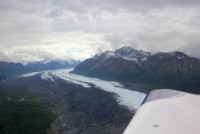 |
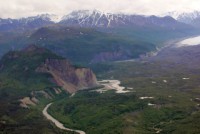 |
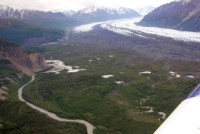 |
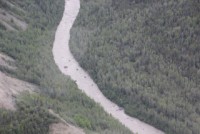 |
In the morning, the group met again and got the bad
news... The weather was worse than planned, and IFR
wasn't an option anyway, because everyone would be in the
ice, and the ice would be bad. So, we had 2 choices.
1 choice, given a 45-55% success rate, was to try the
original flight, making the pass near Whittier, and
continuing down the coast. The other was to fly up to
Gulkana and more inland, and circle back down along the
Copper river, coming out along the shorline near
Valdez. My vote was "Let's just do whichever one has
the best chance of actually getting there.", but everyone
wanted to give the first way a shot. So, we burned
up half and hour of fuel to the pass, only to find it
impassable, and then burned another half hour returning
past Anchorage and continuing on to Gulkana.
Flying up to Gulkana let us fly directly over the
Matanuska Glacier and Lion's head, shown in the photos
above, and we happened to see a group of Nova's whitewater
rafters in the river, too!
|
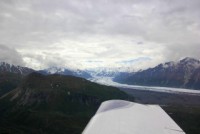 |
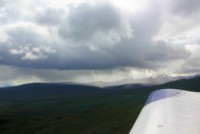 |
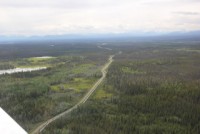 |
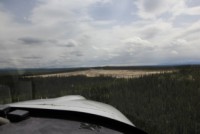 |
Gulkana was a decent fuel stop, and then it was back in
the skies towards the Copper river. Along the way we
passed a large mud volcano, so I dropped down low for a
better look. A few minutes later we were entering
the copper river valley, headed downstream to sea.
|
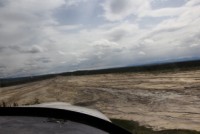 |
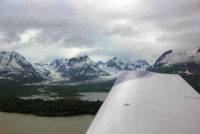 |
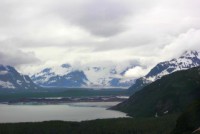 |
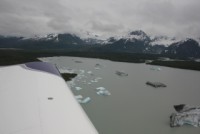 |
After flying the valley for a while, I commented to the
lead that this really shouldn't be an alternate route, but
a PRIMARY route. It was stunningly beautiful in this
valley! He replied that while this was beautiful, we
also did miss out on some other real beautiful things, so
it's a give and take. The glaciers in this river
were awesome, with lots of big ice bergs calving off from
them. Also, the further downstream we went towards
the sea, the ceiling got lower and lower. We knew
the ceiling along the sea was likely in the 400-700'
range, so with luck, we could fly this entire canyon down
to the ocean and stay under the ceiling the whole time.
|
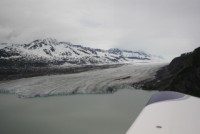 |
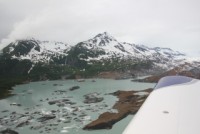 |
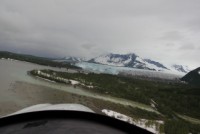 |
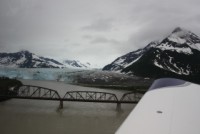 |
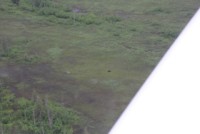 |
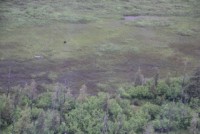 |
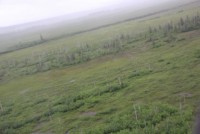 |
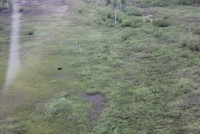 |
Indeed as we got near the sea, the ceiling had dropped
significantly, and we were once again skimming low over
the land at maybe 5-700' or less. We saw another
black bear in a clearing and made a circle around him for
some photos, and then continued down to the coast.
Once on the coast, we were pushed lower yet, under 500'
for sure, but the visibility opened up for a while.
As we flew, we'd hop from rain shower to rain shower, with
periods of good visibility between, but the ceiling had
come down to maybe 300', so we stuck to the coastline for
the most part, and kept our altitude between 50' and 150'
most of the way. One thing about ceilings...you do
NOT want to be right up against the raggedy ceiling. The
forward visibility gets HORRIBLE the closer to the ceiling
you get. So you're often far better being well under
the ceiling, and you can end up getting much greater
forward visibility. We did run through some areas
that maybe got down to 2 mile viz or so, but for the most
part, we flew at under 100' AGL, and had 5 to 10 mile viz
at least. This was plenty doable, despite the
ceilings. We did, however, have to pay very close
attention to birds. There were eagles sitting on
logs basically every 200' as we zipped down the
shoreline. But the seagulls were the ones that were
tough....they would hear the first plane, and take off in
flocks, leaving the remaining planes a little dodging to
do at times. This was our sole issue as we headed
down the shore. This leg along the shoreline
actually ran into the hundreds of miles, so we did this
for a long long time, but it was very very comfortable for
the most part....except for the couple of times we had to
cross the open water of a bay.
|
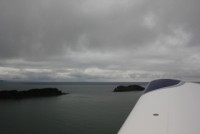 |
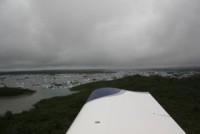 |
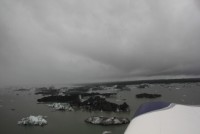 |
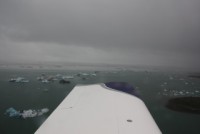 |
This day not only gave us awesome flying, with smooth air,
but some really cool scenery and animal life as
well. We passed some HUMUNGOUS glaciers, with giant
fields of ice bergs. In one berg field, there was a
very odd berg that instead of being a snowy blue, was a
very bright blue like a gemstone...and a clear blue at
that. I did get it on video, so if I get my videos
added to this write-up I'll try to include it there.
|
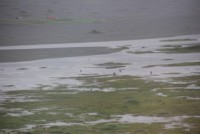 |
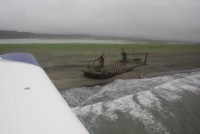 |
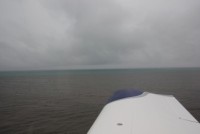 |
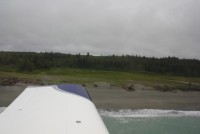 |
Continuing down the coast we saw more wildlife on this
trip than probably any other day. We saw packs of
wolves, bears with cubs, eagles, whales, and many more
things. Zipping down the coast at low altitude may
seem like it would be pretty scary, but one thing we had a
lot of the time was a halfway decent spot to land.
Many of the beaches were clear enough of debris to make an
emergency landing if need be.
We stoped at Yakutat for fuel, and then continued down the
coast towards Ketchikan again. Again we flew by some
huge glaciers, and in the area of the glacier the ceilings
dropped again, likely due to the temperature of the ice.
|
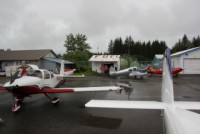 |
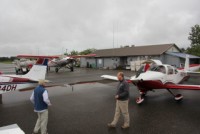 |
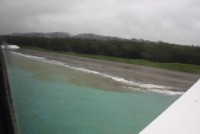 |
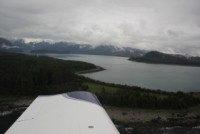 |
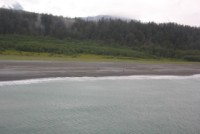 |
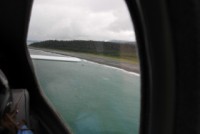 |
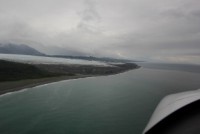 |
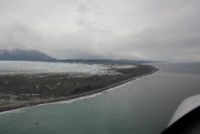 |
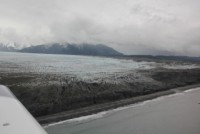 |
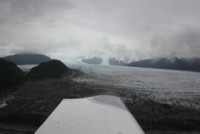 |
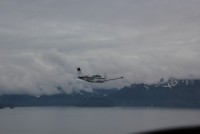 |
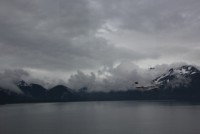 |
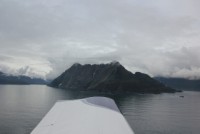 |
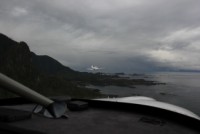 |
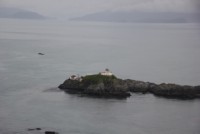 |
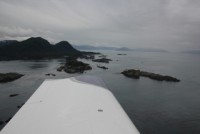 |
Pressing further on, the ceilings finally started to
lift. We also finally started to see signs of human
existance! There was a lighthouse, and then as we
flew up a long finger bay of a large island, we spotted
some whales swimming below us, and passed a boat full of
people. Later on there were cabins appearing, and
finally it almost looked like there were areas of
"community" with a few cabins in one area.
|
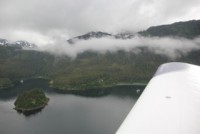 |
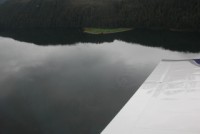 |
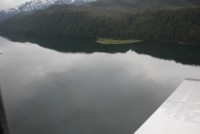 |
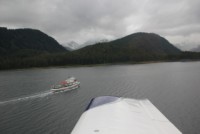 |
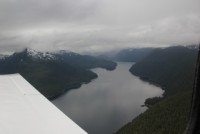 |
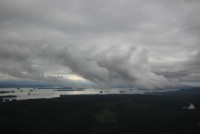 |
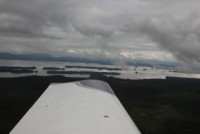 |
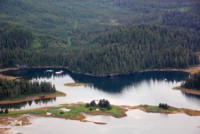 |
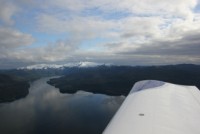 |
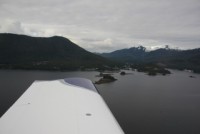 |
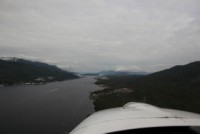 |
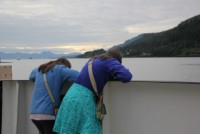 |
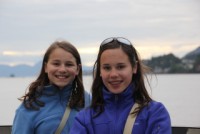 |
Ketchikan is a cool little airport. It's located on
an island across the water from the town. This is
the city that the "bridge to nowhere" was going to be
built in, and let me tell you, after being there, I think
they should fund it. Presently you have to take a water
taxi only a couple hundred yards, just to get from one
shore to the other. They can't be cheap to operate
and they make it more complex to get to the airport.
A small bridge, even a 1 lane bridge, would vastly
simplify things. But, the ferry boat was a cool and
quick trip, so it worked out for us.
|